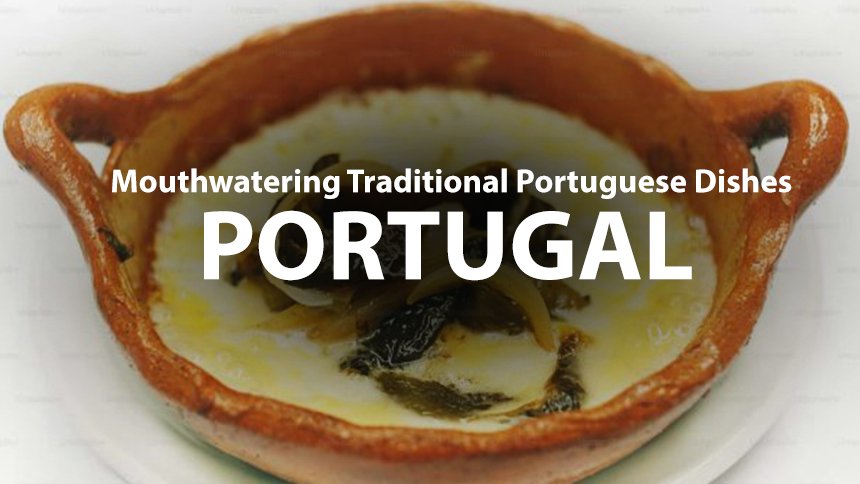When in Portugal, you must try traditional Portuguese dishes. They are a perfect balance of taste and art. You’ll especially love the variety of foods you can enjoy ranging from the fine-dining scene to the street foods, all shining the light on traditional Portuguese recipes they have perfected over time. Here we’ll talk about some of the best traditional Portuguese dishes you must try.
History of the Portuguese Cuisine
Portuguese food is heavily influenced by numerous happenings such as the Age of Discovery – when explorers like Pedro Alvares Cabral and Vasco de Gama set sail for the New World, at the encouragement of the 15-century Portuguese Prince Henry the Navigator.
The Portuguese coastline also ensures that seafood is one of the main ingredients in many traditional Portuguese dishes. However, inland, pork also has a variety of delicacies. For instance, in Alentejo, the slow-cooked Porco Predo (Iberian black pig), bread, and lamb are some of the varieties you’ll find there. Portuguese food also has some classic dishes influenced by African, Brazilian, and Spice Route. Today, you’ll find an explosive delight in cuisines that make for a superb culinary adventure. Now let’s talk about some must-try traditional Portuguese dishes.
Star of the Show: Bacalhau (Salted Cod)
Bacalhau is Portugal’s most famous dish. It’s made using a pre-refrigeration technique of preserving fish in salt. However, despite modern advancements, most salted cod now comes from Norway. So, most dishes would begin with extensive soaking of the Bacalhau in water to remove the salt.
Next, it could be baked as a filet or in casseroles, grilled, and found in a dish made of scrambled eggs, fried potatoes, and onions (Bacalhau a’ Bras).
Some other Bacalhau dishes include Bacalhau a Gomes de Sa (baked in the oven with garlic, olive oil, onion, and potatoes, and Bacalhau com natas (au gratin with cream and cheese). You may also find tons of variations across different restaurants in Portugal with topics like olives and parsley.

Beyond Bacalhau: Diverse Delights
Bacalhau might be the national dish, but Portugal has so many other delectable dishes you’d love to enjoy. Often these dishes include seafood as the central piece surrounded by herbs, spices, and diverse toppings. There are also succulent meals made from ham, chicken, pork, and many more. Now let’s talk about these fabulous traditional Portuguese dishes you should try when you visit. Click here to learn more about the pros and cons of living in Portugal.
Stews and Hearty Dishes
Cozido à Portuguesa (Meat and Vegetable stew)
This hearty dish is a stew dish made from vegetables like potatoes, cabbages, carrots, and turnips. It’s paired with rice and a variety of smoked sausages and meats (often a mix of beef, pork, and chicken). This dish is also native to the Beira region of Portugal. However, different parts of Portugal also have their variations of this meal.
Feijoada à Transmontana (Bean Stew with Meats)
One of the best traditional Portuguese dishes you must try is this dish. It’s a hearty stew made from red beans. It’s also native to the Tras-os-Montes region. However, it’s also said to have inspired the famous Brazilian Feijoada.
Porco Preto (Iberian Black Pork)
This dish is made using Iberian native black picks which were originally brought to Portugal by Phoenicians. They were originally made from interbreeds between swine and wild boars by the Phonecians. However, there are many ways the Portuguese enjoy this meat such as Enchidos (pork sausages), Presunto iberico (charcuterie), and grilled secretos. You’ll especially love the famous Taberna Tipica Quarta which is a variation popular in Evora.
Arroz de Pato (Duck Rice)
This dish is made of a blend of boiled and shredded duck in carolino rice (rice cooked in onions, garlic, and duck stock). Then the dish is baked a bit and garnished with spicy chourico sausage and served with orange slices. That said, this hearty dish also hails from Alentejo.
Prego (Steak Sandwich)
The Prego is an amazing steak sandwich made from thinly sliced garlic-marinated beef served on a Papa Seco bread roll and often drizzled with mustard. Traditionally, this steak sandwich is eaten at the end of an elaborate meal as dessert. The word “Prego ” especially means nail in Portuguese. It demonstrates how garlic pieces are pounded into the steak before cooking. Also, there are many variations of this dish you can try often including toppings like tomato jam, cheddar cheese, pickles, and bacon.

Seafood Specialties
Polvo à Lagareiro (Grilled Octopus)
Polvo a Lagareiro is an amazing dish that originated from the Central Portuguese region called Beiras. This dish is both gorgeous and straightforward. It contains one big meaty piece of octopus with its tentacles, roasted and infused with garlic and olive oil served with slow-baked potatoes.
Ameijoas à Bulhao Pato
This seafood delight, a clam dish, is named after 19th-century poet Raimundo Antonio de Bulhao Pato. It’s made from clams cooked in a sauce made from lemon juice, garlic, olive oil, white wine, and cilantro. Often it’s served with extra bread for dipping.
Arroz de Marisco (Seafood rice)
Arroz de Marisco is an amazing dish made from varied ocean delights such as crustaceans fresh, bacalhau, and tamboril (monkfish) in a slightly soupier version of risotto. You can also try a version that uses massadas (pasta) instead of rice.
Lapas (Limpets)
Lapas or Limpets in English are a type of small, edible aquatic snails native to Madeira and Azores. These snails are often cooked with garlic and butter and served with slices of lemon, especially if you are going to the Azores.
Cataplana de Marisco (Seafood stew)
This delightful stew is named after the vessel where it’s cooked and served. The Cataplana is a clam-shaped copper cooking pot predating the modern pressure cooker. This pot allows for steam-cooking ingredients in their own juices. Often this delight is a steam-cooked meal loaded with shrimp, fish, or other crustaceans in a mix of white wine, herbs, spices, and vegetables like bell pepper, onions, tomatoes, and cilantro. The dish is also famous in the Algarve where every beach town serves it.
Migas
Migas is a great dish from Alentejo. It’s made from pork, tomatoes, olive oil, red peppers and fresh coriander. However, this traditional dish is often served as a side with other dishes. But you can be sure to get pretty full in the end.
Caldeirada de Piece
This stew is also one of the best traditional Portuguese dishes. It is made from different types of fish like cod, monkfish, shellfish, and mackerel cooked in a sauce made from garlic, tomatoes, onions, and spices. You can have this with some crusty bread on the side.
Sardinhas Assadas (Grilled Sardines)
Grilled sardines are a Portuguese delight, best enjoyed during the summer festive seasons. You’ll find that aroma filling the air among the traditional neighborhoods of Lisbon during that time. Also, the June celebrations of saints like Santo Antonio are a time to have this delightful snack. Although quite delicious, the dish is simple. It’s sardines seasoned with coarse salt and then grilled over hot coals. These sardines are then eaten with bros (cornbread). However, in restaurants, it’s served with boiled potatoes and bell pepper salad.

Sweet Endings: Portuguese Pastries & Sandwiches
Pastel de Nata (Custard Tarts) – a national treasure
The Pascal de Nata is considered Portugal’s most famous dessert. It is a tiny, decadent egg tart with an enriching taste, yet sells for under 2 Euros. The Pastel de Nata can be traced to the Jeronimos Monastery in the Lisbon district of Belem. Centuries ago, Monks and nuns would starch their clothes with egg whites.
So they often had plenty of leftover yolks which they baked into savory delights. After the Liberal Revolution of 1820, faced with the closure of monasteries and convents, they began selling their tarts at a nearby sugar refinery to make money. That said, the original recipe is entirely secret. However, it’s made of creamy egg custard filling and a flaky pastry shell. Powdered sugar and/or cinnamon is also sprinkled over the top to taste.
Acorda (Bread in Broth)
One of the best ways to enjoy rock-hard bread is the Acorda. Here the bread is rehydrated using hot water, garlic, olive oil, and cilantro or in other stocks or broth versions and then served with a load of seafood. This dish traces back to Arabian immigrants and is a variant of the Arabic word for “bread soup”. That said, some restaurants like the Solar dos Presuntos in Lisbon have lobster versions made as shellfish porridge. This variant comprises shellfish, in the mushy bread mixture and then drizzled over with the restaurant’s homemade piri piri (hot sauce).
Francesinha (Sandwich from Porto)
Portugal’s Little Frenchie is just a delightful snack made of two slices of bread, roast beef, or steak, plus wet cured ham, linguica sausage, and melted cheese. Sometimes, it comes with a fried egg. And it can be infused with hot tomato and beer sauce with french fries on the side.
Bifanas
Bifanas are a more simple sandwich. It’s made from pork strips seasoned with white wine, garlic, and other spices. However, the toppings vary from one region and restaurant to the next. Often this sandwich is enjoyed as a late-night snack. But you can have it anytime you like.
Ovos Moles (sweet egg yolks and sugar confection from Aveiro)
The Ovos Moles is yet another dessert with a monastic origin. It’s one of the best traditional Portuguese dishes. However, it’s made with 2 ingredients: egg yolks and sugar combined into a paste and then poured into tiny molds shaped like shells or fish.
There are many other delights especially desserts that expand your horizons bringing new aromatic smells and tastes. Portuguese cheeses especially are less known and very unique. You’ll love the Serra da Estrela, a sheep’s milk cheese, or Sao Jorge from the Azores, a semi-hard cow’s milk cheese with some spiciness.
Conclusion
There are many traditional Portuguese dishes you can enjoy depending on the type of culinary adventure you’re willing to embark on. Plus, you’ll find that different areas of the country may have different variations of similar dishes making for a true and amazing tasty journey.
Frequently Asked Questions about Traditional Portuguese Dishes
What is the national dish of Portugal?
Portugal doesn’t have an official national dish. But Bacalhau (salted cod) is widely considered Portugal’s most iconic dish. Its versatility and historical significance make it a true representative of Portuguese cuisine.
What is Portugal famous for?
Portugal is famous for many things such as beautiful beaches, stunning coastlines, rich history, Fado music, friendly people, and delicious food.
What are Portuguese tapas called?
Portugal doesn’t traditionally have tapas like Spain. However, they do have similar small plate offerings called Petiscos. These are perfect for sharing and come in a variety of flavors, from seafood to cured meats and cheeses. Even so, you’ll find tapas served across many different restaurants that cater to a more international menu.
What is the most popular meat in Portugal?
Poultry meat is one of the most popular consumed meats in the country. This is followed closely by pork, beef, and seafood. Pork, made from the Iberian pig, is used in a variety of delicacies known to the southern and central parts of Portugal.
What are 3 common foods in Portugal?
Bacalhau (salted cod), and Pastéis de Nata and Sardinhas Assadas são alguns are some of the most common foods in Portugal.
What food is Lisbon known for?
Lisbon is known for a variety of delicacies. But a couple of specialties stand out such as the Arroz de Marisco (seafood rice) made from shellfish, fish, and rice in a delightful broth, and Pastel de Belém, known for its unique crust and creamy custard filling.






